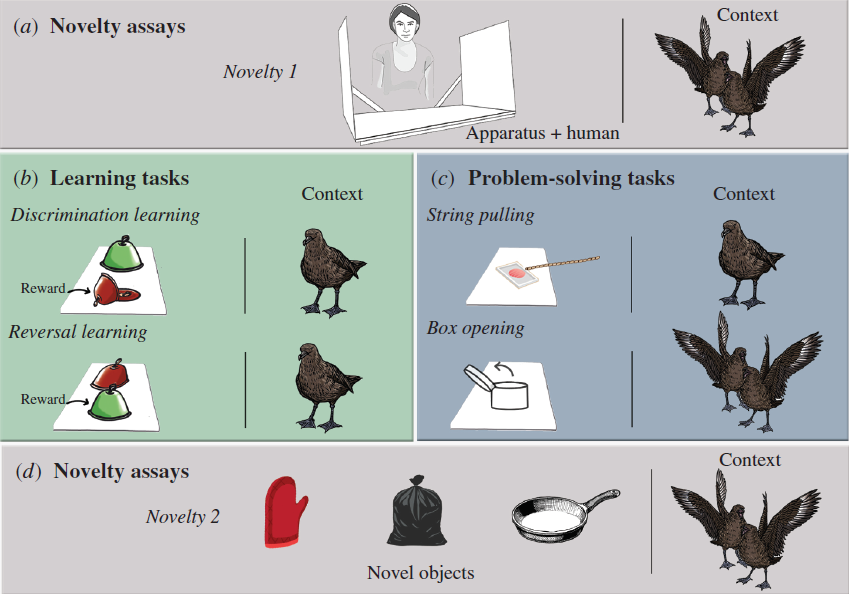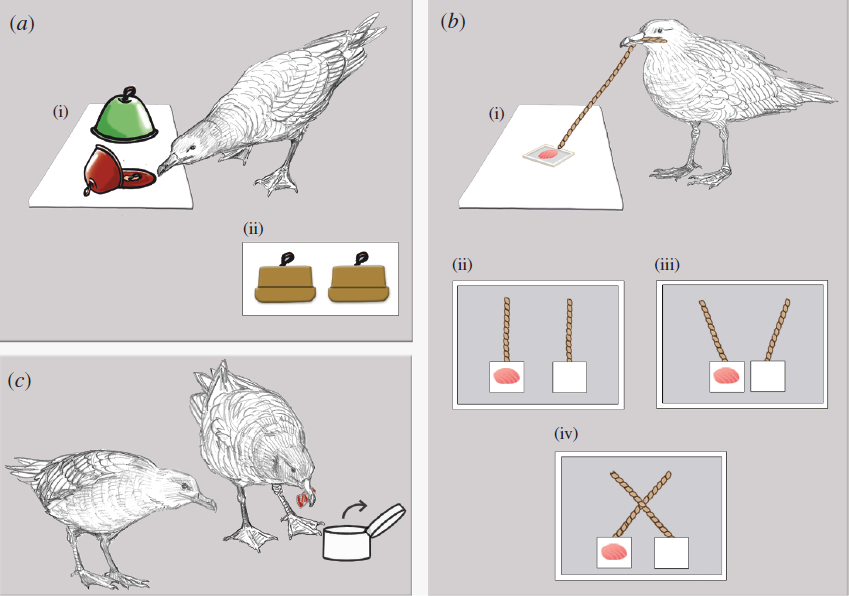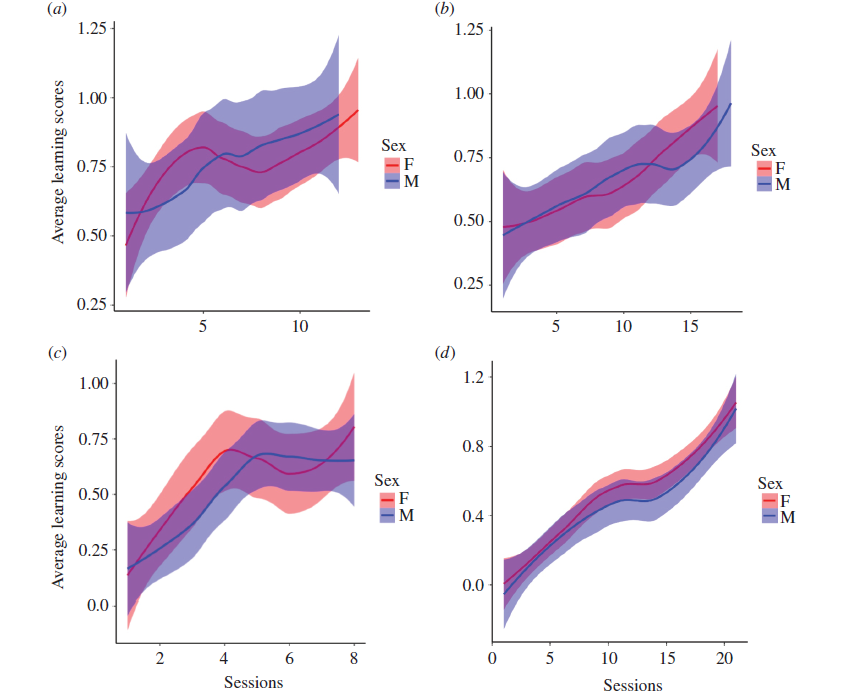Initially, cognitive research aimed to quantify cognitive differences between species. However, researchers now find that not only are there significant cognitive differences between species, but also among individuals within populations. To understand the consistency of these individual differences, cognitive research has begun to integrate with the field of personality.Personality is defined as the behavioral differences exhibited by individuals across different times and contexts, which are often related along a fast-slow axis (for example, individuals with high aggression may also be bold and active, a phenomenon known as “behavioral syndromes”). An animal’s personality (such as boldness or caution) may influence how they learn. For instance, bold animals may learn quickly but have a weaker ability to adjust their behavior in changing environments.Sex may influence animal behavior and cognition, but previous studies often overlook this aspect. However, due to differences in ecological roles and reproductive strategies between males and females, sex may be a key factor affecting cognitive performance.
The study selected a breeding population of wild Antarctic Skuas Stercorarius antarcticus for research, with results published under the title Sex predicts response to novelty and problem-solving in a wild bird with female-biased sexual dimorphism in the Proceedings of the Royal Society B in December 2024.


The research was conducted on Île Verte in South Georgia, involving six pairs of breeding Antarctic Skuas. The Antarctic Skua is a bird with a larger female size (female-biased sexual dimorphism), with females being 5% to 16% larger than males, and females showing a more positive response to novelty. The behavioral traits of this bird (such as being approachable to humans and high territoriality) make it an ideal model for studying the relationship between sex differences and cognition. The study included a series of learning and problem-solving tasks, as well as tests assessing the birds’ responses to novelty (Novelty 1 and Novelty 2).
Tests for response to novelty:
- Novelty 1: Assessing the willingness of female and male Antarctic Skuas to obtain food rewards in the presence of novel objects (experimental apparatus). Before the experiment began, the experimental apparatus (a portable white foam board) was placed in the territory of each breeding pair. When both breeding birds were present, the experimenter gradually approached the nest, placed food rewards on the apparatus, and recorded the time and number of trials taken by the birds to obtain the food.
- Novelty 2: After all other tasks were completed, the birds’ responses to novel objects were reassessed to verify whether the behaviors observed in Novelty 1 were consistent.
Each breeding pair was presented with three different novel objects (an inflatable trash bag, a red plastic basin, and a frying pan covered with aluminum foil). The time and number of trials taken by the birds to obtain food were recorded.
Learning tasks:
- Food association learning with color and spatial cues (Discrimination-learning task): The Antarctic Skua needs to learn to associate food rewards with specific colors (such as a green container) or locations (such as the left container). In the experiment, two containers of different colors or positions were presented simultaneously, with only one being the source of the food reward.
- Reversal learning (Reversal-learning task): After the birds learn the association of color or spatial cues, the reward conditions are reversed. For example, the reward previously obtained from the green container is now obtained from the red container. This task is used to assess the birds’ ability to adjust their behavior to adapt to environmental changes.
Problem-solving tasks:
- String-pulling task: The Antarctic Skua needs to learn to pull a string to obtain food rewards. The experiment includes different conditions, such as single string, parallel strings, converging strings, and crossed strings, to assess the birds’ goal-directed behavior and problem-solving abilities.
- Box-opening task: The Antarctic Skua needs to open a box containing food rewards. This task assesses the birds’ exploratory behavior and operational ability to see if they can successfully obtain hidden food.

Figure 1 Overview of the series of cognitive tasks and neophobia tests conducted in the experiment. The four parts of the chart illustrate different experimental tasks, testing situations, and experimental procedures.
Table 1 Results of post hoc tests for different tasks and situations in learning tasks, listing the contrast estimates, standard errors (s.e.), z-values, and p-values between different tasks (color discrimination learning, color reversal learning, spatial discrimination learning, spatial reversal learning).


Figure 2 Overview of the three cognitive tasks conducted in the experiment.
Table 2 Individual performances of Antarctic Skuas in problem-solving tasks, including string-pulling and box-opening tasks.

The research results indicate that female Antarctic Skuas accept food rewards in novel environments faster than males, exhibiting lower neophobia; there were no significant differences in performance between males and females in learning and reversal learning tasks; females performed better than males in the parallel condition of the string-pulling task, and in the box-opening task, all behaviors of first contact and opening novel foraging boxes were completed by females.

Figure 3 Gender-specific learning curves of Antarctic Skuas in learning tasks, including discrimination learning and reversal learning tasks in color and spatial contexts. The learning curves are represented in red for females and blue for males, with shaded areas indicating the 95% confidence intervals.
The research results suggest that sex does not directly affect cognitive performance (at least in the tasks conducted), but the performance of females in problem-solving tasks may be related to their lower fear and higher motivation. The lower fear in female Antarctic Skuas may be associated with their higher energy demands and motivation levels, which could explain their success in problem-solving tasks.This study emphasizes the importance of considering sex differences in field studies and proposes future research directions, including exploring the physiological basis of sex differences (such as hormone levels) and how different ecological demands influence sex-specific behaviors and cognition. However, the sample size of this study is limited and only focuses on Antarctic Skuas, necessitating more data from other species to validate the generalizability of the conclusions. Future research could explore sex differences under different ecological conditions and how these differences affect the survival and reproductive success of birds.
P.S. The cover is an image generated using Stable Diffusion, not representing the true appearance and habitat of the experimental animals, described by Kimi: “Soft morning light filters through a thin mist, casting a cool blue and purple hue over the icy landscape. In the foreground, a female Antarctic skua with warm brown and gray plumage stands beside a simple experimental setup—a white foam board on the ground with strings and a food reward. Her posture is curious, head tilted, eyes focused intently on the strings. Other skuas are in the background, some approaching tentatively, others observing from afar. The brushwork is loose and fluid, with visible strokes adding texture. Distant mountains and ice plains blend into the horizon with broad color washes. This scene captures a moment of exploration and discovery in a natural, Antarctic setting.”